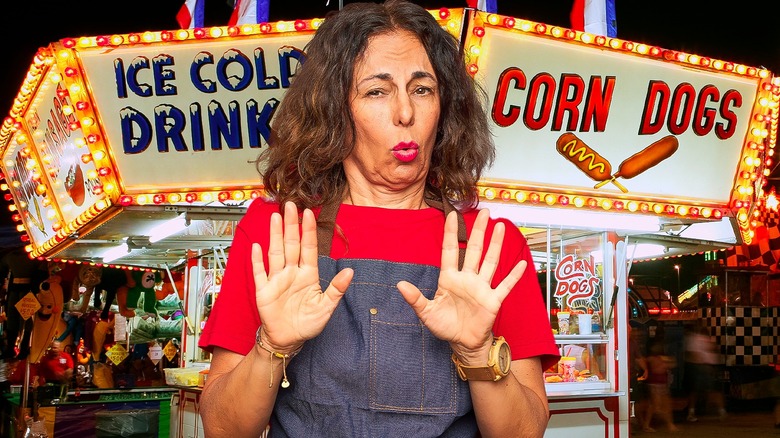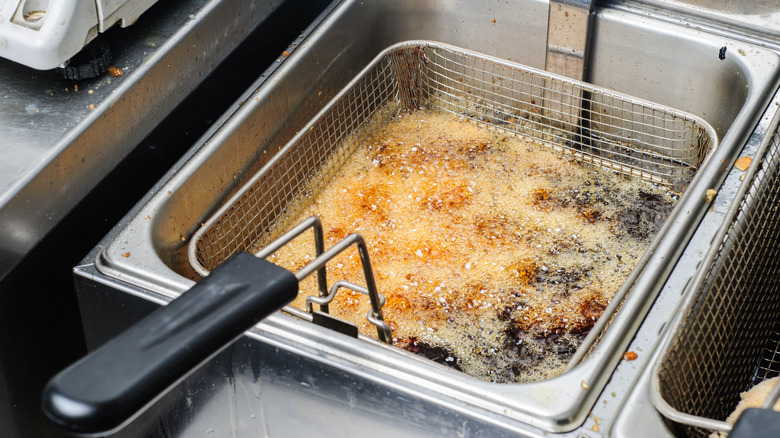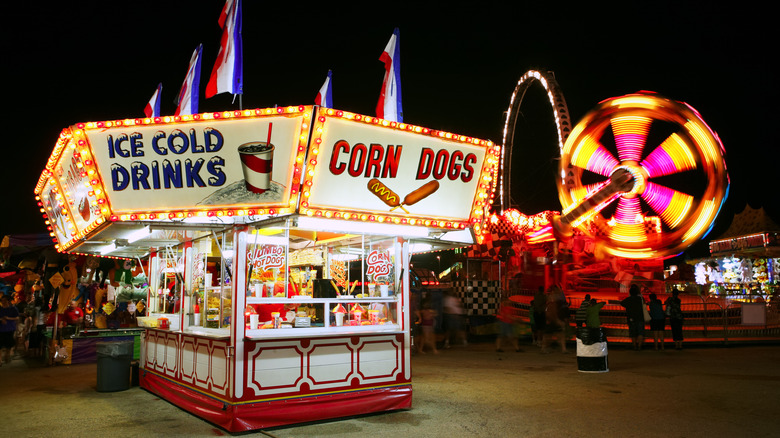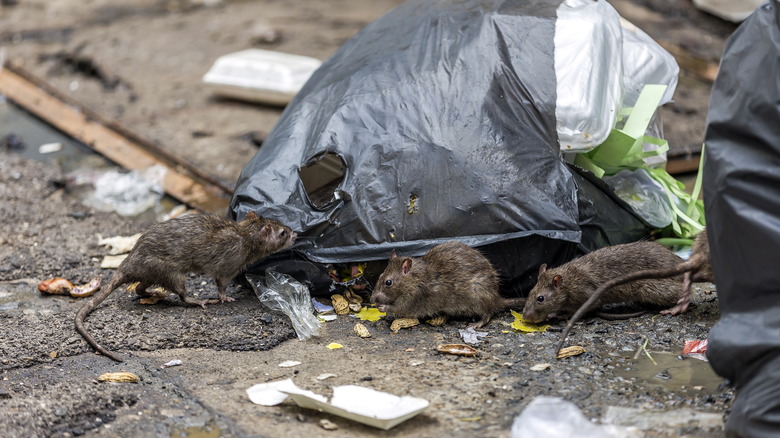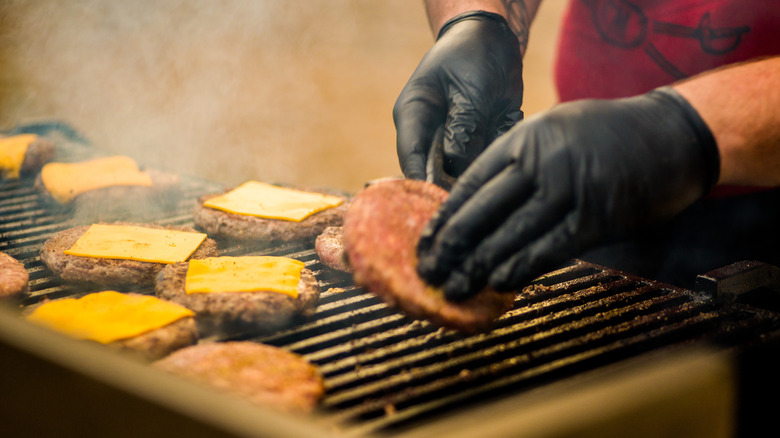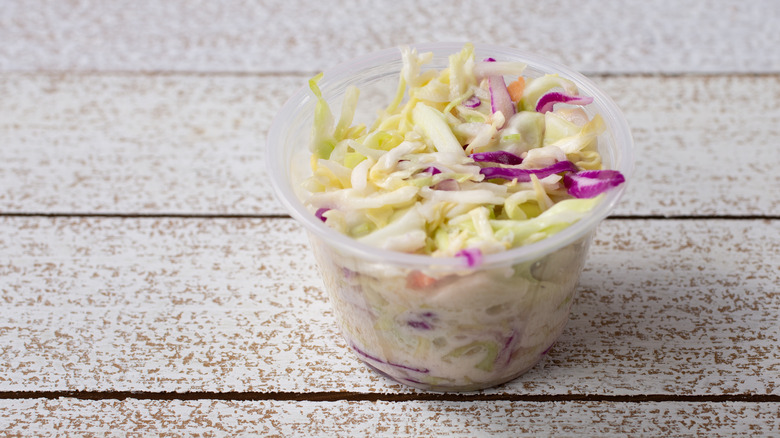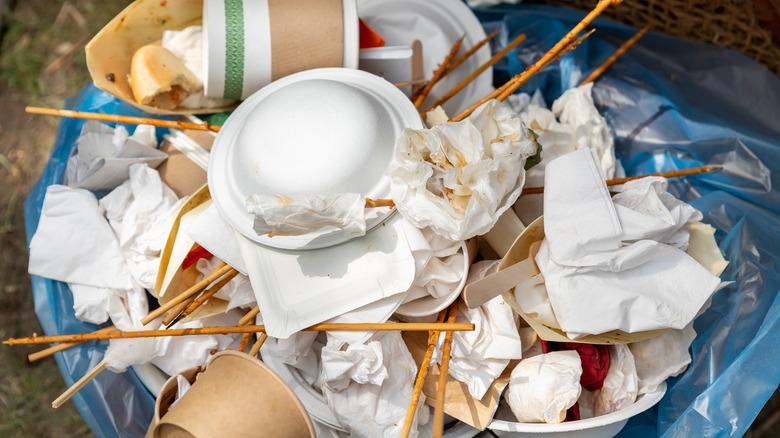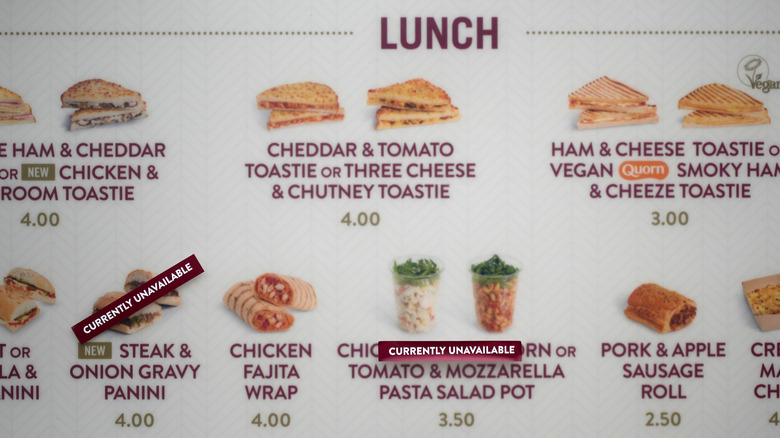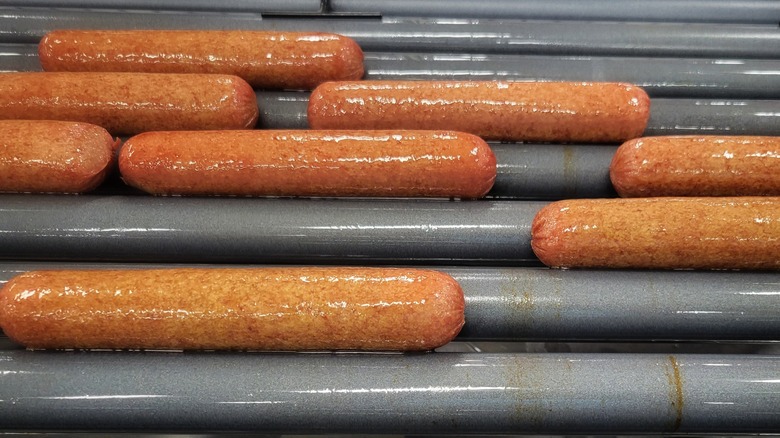15 Red Flags At A Concession Stand That Should Make You Turn Around
There are plenty of reasons to go to a concession stand. Perhaps it's been a long day in the sun at the beach or amusement park, and you can't fathom the drive home without something in your system. Maybe that haunting smell of fried dough has tortured you since you arrived at the stadium or carnival. It could be a tradition that you and your father grab a footlong hot dog before each game, or buttered popcorn before every movie. Whatever the reason, rarely do people go to a concession stand to enjoy a farm-to-table or five-star meal. It's usually quick, greasy, and salty, and that's the way we like it. However, when it comes to your health, it's important to be aware of the red flags at a concession stand that should make you turn around and choose an alternative vendor.
Nobody is looking for a candle-lit gourmet meal on a white tablecloth here, but it is important that the food your eating should always be safe. Staff members should follow strict guidelines and cleaning protocols to ensure everyone's safety, and to lower the chances of cross-contamination. Foodborne illness should not be a concern when dining anywhere, even at a stand, so if you encounter any of these red flags, skip the concession stand altogether or opt for a pre-packaged snack or drink, instead of one prepared or heated on sight.
1. The stand is in disrepair
Even if you're at the country's oldest stadium, walking through rickety wooden bleachers with chipped paint, the concession stand where you're ordering that first ballpark dog of the season should be spick and span. Are you noticing that their signage is falling apart? Are they serving baskets of fries and soda on a chipped or cracked counter? Are the grill vents hanging by a thread? Even if it matches the rest of the park's energy, this is a red flag, and the standard of a clean food environment should be higher.
Anywhere that's serving or preparing food should be updated, freshly painted, and lacking chips and cracks. Any crevice becomes a hard-to-clean area where bacteria will thrive and fester, per the Food and Drug Administration. Furthermore, chipped paint, especially old paint that may contain lead, according to the Centers for Disease Control, has no place near food. Often, a concession stand in a stadium with rotting wood can also indicate pest infestations like termites, as stated by Midwestern Pest Control. This means wood dustings, insect excrement, and even old nails could be showering from the ceiling. Play it safe, grab a sealed bag of chips and a soda, and get that ballpark dog at the next away game.
2. The smell of rancid oil
Ever smell a concession stand before you actually see it? Sometimes it's that unforgettable aroma of fried dough, sometimes the sweet scent of cotton candy, and if you're lucky, you might even get a whiff of shawarma or fried chicken. However, the scents coming from these stands aren't always so pleasant. The smell of rancid oil can be quite pungent and has an overall "off" scent, which can be sour or even mimic the smell of metal or crayons. Fryer oil should closely resemble the oil you cook with at home. It should not be an overwhelming scent, but rather quite subtle.
While you can reuse fry oil, certain protocols must be followed to keep it safe, per the United States Department of Agriculture. In addition, there is a limit to the number of times it can be reused, which should be strictly upheld. Old fryer oil should be cooled when not used, and thoroughly strained from any bits and pieces of food. In addition, the more hot fryer oil is reused, the more carcinogenic it becomes, per Cancer Prevention Research. Therefore, sticking to fresh oils is always best, and tastes better as well. If you can smell bad oil from afar, don't even bother checking out their menu.
3. Lack of a license
Any food stand owner, no matter how small the cart or structure, should have a license to show that proves they legally own and operate their place of business. These businesses are held to a certain standard regarding health and safety and are monitored by governing entities that ensure they are within regulations. For instance, to obtain a food service license, you have to meet all of the safety regulations as required by law. Although your favorite hole-in-the-wall concession stand may serve up some delicious and inexpensive treats, if you're worried at all about the quality and safety of the food, consider asking to see their license.
Most stands will have this license within view of the customers, but if you don't see one, then politely ask if you may take a peak. They may be busy, so try and be patient if it takes a moment for them to dig it up, which most places will be happy to do. If they are resistant or refuse, it's likely their license is outdated, or worse, nonexistent. This is the bare minimum, so don't feel bad choosing another place to grab a bite. Your safety should always come first, and having a current license is not too much to ask of a business.
4. Animal traps in plain sight
Yes, pests are a part of life. Any homeowner knows that. And when it comes to summertime, there's no stopping bugs from harassing just about everyone, and outdoor concession stands are no exception. However, a stand that has mouse or fly traps out in the open, within customer view, indicates their management either has little regard for the customer's experience, or the problem has gotten so out of hand that they are desperate. Dead pests should not be on your radar when you're thinking about food. That's a no-brainer.
Besides the ick factor, pests spread foodborne illnesses that can make you sick, or worse, can be deadly, per Environmental Health Insights. And although nobody can really prevent flies from buzzing around in the open air, there's usually a reason that rodents have been attracted to a stand: It's much easier for pests to get food scraps at establishments that don't have a strict cleaning protocol. Crumbs, dirty surfaces, ground-level stored food, and waste that sits overnight can all attract the creepy crawly creatures that should have no business near our food. Play this one safe and leave the snacking for the mice at this concession stand.
5. Employees using gloves to handle money
Although it's always a win to see concession stand employees wearing gloves, it doesn't make a bit of a difference if they are using them improperly. Ever seen someone use the same gloves they handled money with to then make your sandwich, or put together your hot dog? This is actually quite common, as gloves protocol is a fairly new concept to many concession stands and food trucks after the fears of COVID-19 spurred their popularity. The gloves are supposed to protect the food, not the server, but this can go overlooked or not properly understood.
Typically, the gloves should be disposed of once the food is prepared and served, and then a new set should take its place once the server is done with the cash register, or after handling another customer's food. Technically, a hand wash should occur before a new set of gloves is put on, but we're just happy that someone's wearing and changing gloves at all at a concession stand. Feel free to politely ask your server to pop on a new set of gloves if you're concerned about bacteria, pathogens, or cross-contamination, which can be prevented by using gloves, per the Journal of Food Protection.
6. Greasy surfaces all over the place
If a concession stand is caked with grease stains, discolored surfaces, and overall grime, then run in the other direction. These kinds of buildups only take place if an area isn't well maintained, or rarely cleaned. Appliances, surfaces, and floors should be deep cleaned nightly and wiped down during the day.
If this isn't happening, then it's safe to say that other protocols are falling by the wayside. If the clean-down crew doesn't scrub the countertops, when was the last time they disinfected the cooler? If they don't mop nightly, then maybe that fryer oil hasn't been changed out recently. Grease stains take a while to set and build up over time, and there are plenty of easy and chemical-free ways to clean appliances. Grease and grime should be a top priority, and if it's not, then it's likely management doesn't focus too heavily on cleaning protocol. Take your business elsewhere.
7. Bad reviews are a little too common
Although you may not think to check Yelp or Google reviews at a concession stand, it may be worth the extra effort. If nothing else, you can be sure of one thing: Yelpers will give their honest and unfiltered opinion if they've had a bad experience. And while you can't take every single review to heart, a place with a decent amount of good or bad reviews can give you a general idea. If you see the words "food poisoning" more than once, for instance, take that as a red flag and turn around.
In addition, if all of the reviews are from influencers, then you can bet they were paid promotions. You likely won't see this at a concession stand unless it's famous for a flagship product or famous on social media. However, it's always nice to see if there are any consistent themes regarding the quality of food, how management treats employees, or health concerns.
8. Hidden health inspection rating
Any concession stand with a primo health rating would be proud to display the report. If it's out of sight, it's likely — but not necessarily — poor or worth hiding. If you see a health rating below an A, or especially B, then take that as your sign to go elsewhere. Feel free to politely ask an employee to see their health rating, especially if you have your doubts about their cleanliness by looking at the stand itself.
However, even if the stand looks like it's in top shape, the employees are decked out in hairnets and gloves, and everything is squeaky clean, this doesn't necessarily mean that all protocols are being followed. Health inspectors test things like how long a product has been sitting out without refrigeration, if the refrigeration systems are working properly, if the vents are clean and clear, and if there is proof that any hot foods are coming to a temperature known as a "kill step" before being served, per the Department of Health and Human Services. Trust your local health inspector, and look for that rating.
9. Lack of gloves or hairnets
After COVID-19, it's commonly expected that anyone handling ready-to-eat food should be wearing gloves. Furthermore, it's always nice to see employees with hats or hair nets, so you won't be pulling a strand of hair out of your mouth a few bites in. Often, the same red flags that indicate you shouldn't visit a food truck apply to concession stands, and the use of gloves is one of them.
Even if the entire food prep area is spick and span, sweat, dead skin cells, fingernails, and pathogens can find their way from an ungloved hand into food, per State Food Safety. And while many restaurants don't use gloves behind closed doors, it's always nice to see that a concession stand has made an effort. Even if employees are simply scooping ice cream, salting french fries, or dusting fried dough with powdered sugar, gloves can keep everyone safe, and provide reassurance that food safety is a priority to the crew.
10. The menu is never-ending
When it comes to concession stands, we're typically just looking to get a quick, if not fatty or salty, fix. We aren't expecting a wine pairing and red carpet, but it is nice to know that your food is relatively fresh, and a decent amount of effort goes into making it. Of course, if you're going for a soda and a bag of potato chips, by all means, grab, pay, and go. But if you notice that the hot foods menu goes on and on for days, then it indicates that everything is likely premade and frozen.
We know there aren't elves behind every concession stand hand-cutting french fries from freshly dug potatoes, but it's always nice to see that when a stand serves hot food, at least a little love goes into it. If there are endless menu items, then there is no way, especially in the amount of space they have, that the menu items are getting any kind of special attention, or even being heated to order.
11. Refrigerator items are sitting out
We love it when a concession stand has healthy options, like a fruit cup or serving of coleslaw. It's a rare find, but heaven-sent for those of us trying to stay in shape and keep our bodies strong. But there is a reason that we don't often see these kinds of foods at a concession stand, and that's because they require refrigeration and recording and tracking of expirations. With that comes a whole new set of protocols which can complicate things. Ready-made fried food either gets eaten or thrown out (hopefully), and shouldn't be stored overnight and sold the next day.
If you see that fresh cup of food sitting out on the counter, displayed but not refrigerated, then it's time to turn around. Even cold cut or cheese sandwiches should be kept at a certain temperature to ensure their safety. So how long exactly can food be stored on the counter after cooked? The two-hour mark is a safe bet, according to the FDA. And that's right after it's gone through a high-temperature kill step. Unless those sandwiches or fruit cups are being pulled from a cooler, you could be at risk for foodborne illness.
12. The area around the stand is trashed
It's easy to tell when a concession stand is kept clean. Is the garbage overflowing? Is there trash on the ground? Are you walking through a sea of popcorn to reach the front of the line? Sometimes this can indicate that the employees either don't take pride in their work, or there is no structured management to keep things regulated. Trash and food scraps attract pests, and you don't want to purchase food already picked through by furry or six-legged creatures.
In addition, any establishment selling food should be putting its best foot forward when it comes to customer satisfaction, and if customers have to wade through a sea of garbage just to order, this isn't a priority. Poor management could also indicate that other health and safety protocols are slipping through the cracks, or that employees are cutting corners because they are too overwhelmed to keep up with the workload. Either way, it's best to play it safe and choose another place to grab a bite.
13. They're out of everything
It's always a little disappointing when a concession stand is sold out of your favorite snack, but that's a good thing, right? It means they are so popular that they are having trouble keeping up with demand. While that could be the case, when a stand or restaurant is out of most of its menu, it typically indicates a glitch in the system, which could be a reflection of management or staffing issues. And while supply chain issues are not always the management's fault, it's certainly something to note.
There is an exception, however. Some concession stands that make a flagship fresh product will plan to sell out daily, and close down when they do. Typically, this will be posted on their website, or on a sign out front with their business hours, for example, "Open 8 a.m. until we are sold out, so come early and get them while they're hot!" In that case, ride that green light and enjoy your freshly-made treat.
14. The environment is chaotic
Ever been to a restaurant, food truck, or concession stand where the employees look like they are one order away from losing it? Even if the sweat, blood, and tears haven't come out yet, that doesn't mean it's not happening behind closed doors. It also indicates that each staff member is in over their head, meaning they are focusing solely on the tasks at hand, with other duties falling to the sidelines, and reasonably so.
It's quite possible that those forgotten duties could include basic cleaning, glove changes, temperature checks, and sanitation. Unfortunately, each of those tasks are just as important as getting someone their food to ensure customer safety, so it's imperative that employees have enough time to perform those duties. While it's okay to have sympathy for the overworked staff (we've all been there), that doesn't mean you have to risk your health. Choose another concession stand, or opt for prepackaged foods not prepared on-site.
15. Food is sitting under a heat lamp
Whenever you consume fried foods, it's best if it's made to order, or recently fried. As we know, it simply tastes better when fresh out of the frier, but it's also healthier to consume fresh oil, rather than oil that sat for some time. Most foods should not be heated multiple times, which is why you shouldn't reheat leftovers more than once, per Food Standards Scotland. The same rules apply when it comes to concession stand foods.
You've probably seen those heat lamps or rotating hot dog heaters that house fried and greasy foods. It's anyone's guess how long they've been sitting there, or when the last time they were swapped out with fresh product. This goes for fried meats and vegetables, burgers, sandwiches, and pretty much any other hot food. It will be much fresher if it's made to order, or made recently, and reduces the chance of bacterial growth from sitting out too long in the temperature danger zone, per the USDA. And let's be honest, who wants a dehydrated, reheated, tough-skinned fried chicken wing, when you can get one that melts like butter in your mouth?
